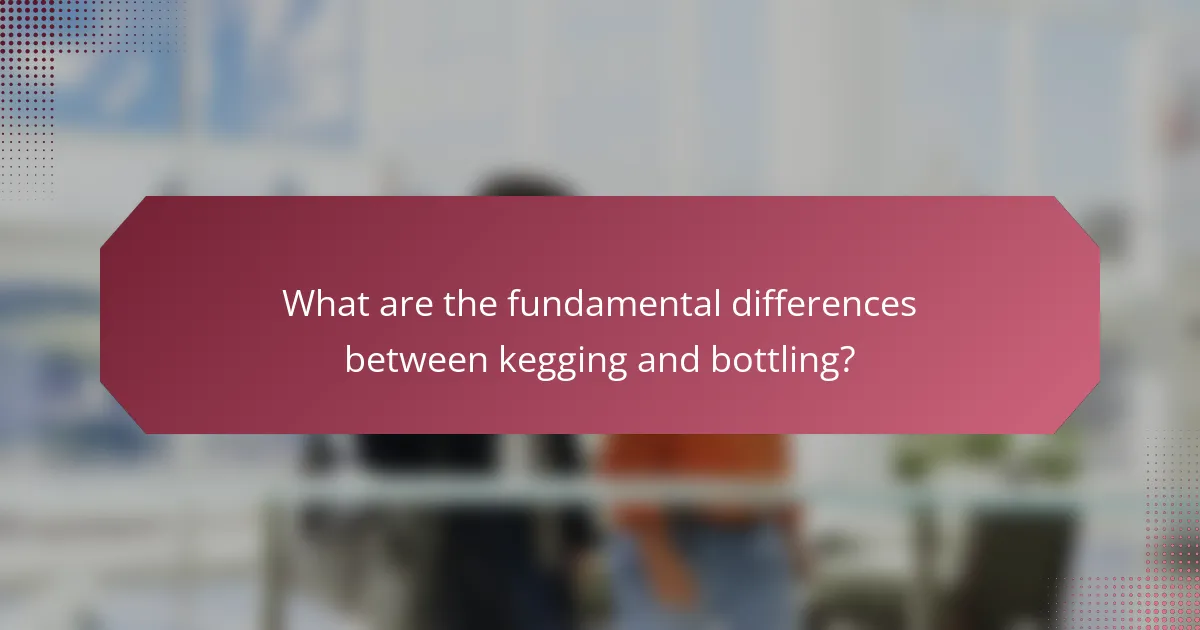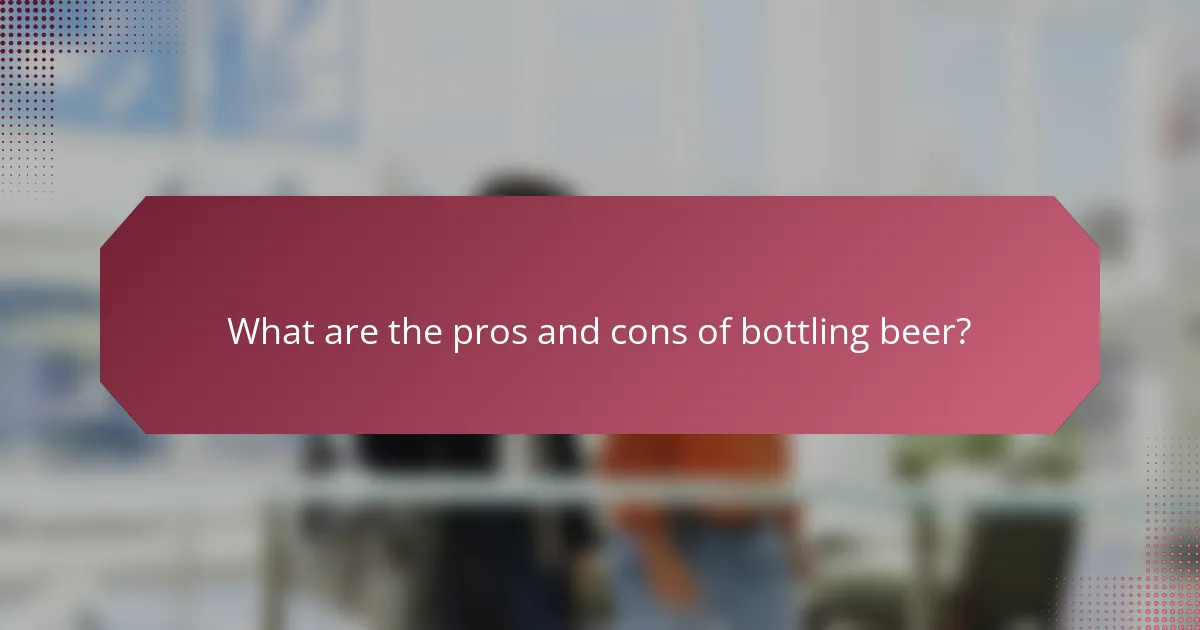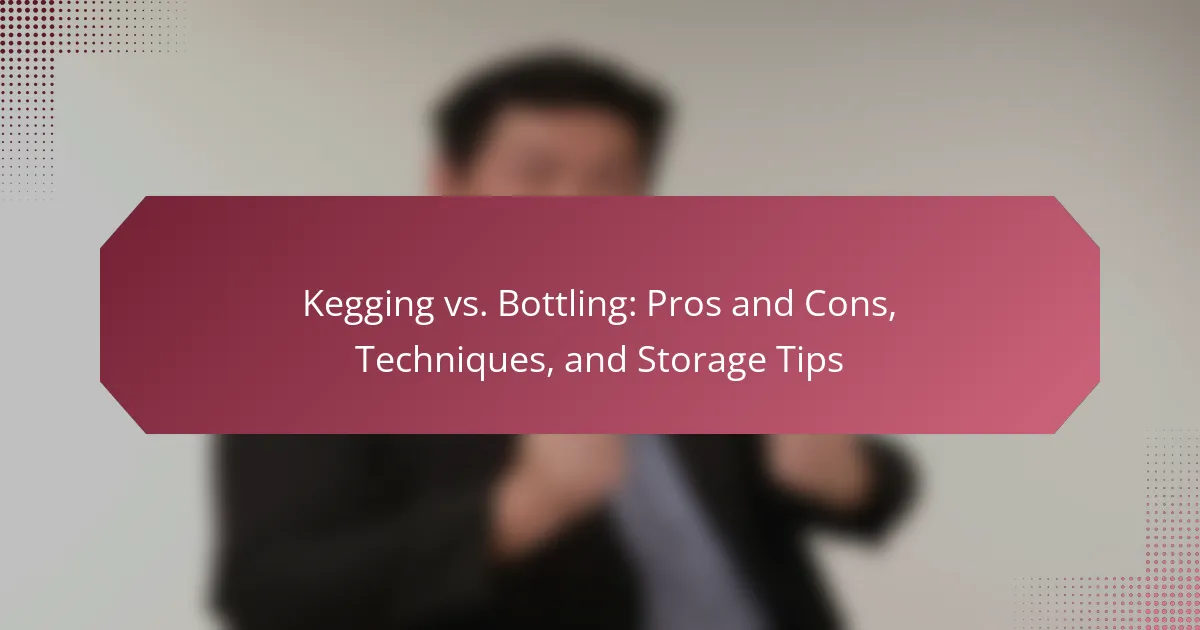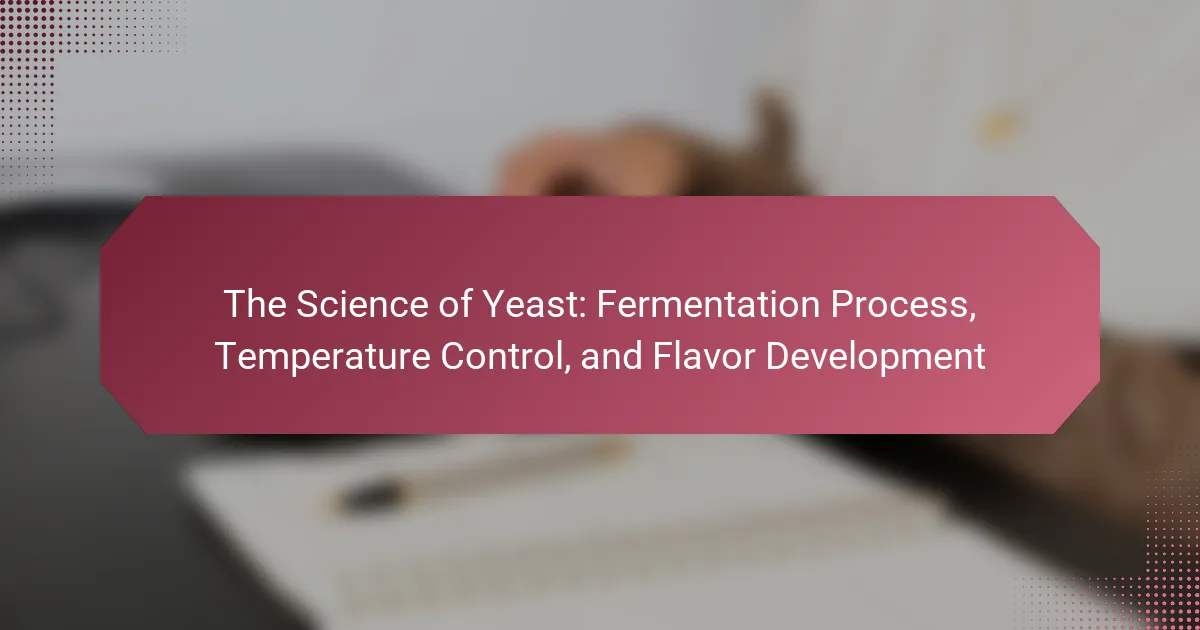Kegging and bottling are two primary methods for storing and serving beverages, each with distinct advantages and disadvantages. Kegging allows for quicker access to larger quantities while minimizing oxidation and contamination risks, making it ideal for on-tap service. Bottling offers portability and longer shelf life but poses risks of oxidation and higher costs. This article explores the pros and cons of both methods, effective techniques for kegging and bottling, and essential storage tips to maintain beverage quality. Key factors such as sanitization, pressure control, and temperature management are also discussed to enhance the overall drinking experience.

What are the fundamental differences between kegging and bottling?
Kegging involves storing and serving beverages from a pressurized container, while bottling uses individual glass or plastic containers. Kegging allows for quicker access to larger quantities. It also minimizes oxidation and contamination risks due to fewer handling steps. Bottling, on the other hand, is more portable and allows for individual servings. Bottles can be sealed for longer shelf life but may introduce oxygen during filling. Kegging systems require specific equipment, while bottling can be done with basic tools. Kegging is often preferred for on-tap service, while bottling is common for retail distribution.
How do kegging and bottling affect the quality of beer?
Kegging and bottling impact beer quality significantly. Kegging typically preserves carbonation better than bottling. This is because kegs can maintain consistent pressure, preventing oxidation. Bottles, especially if not capped properly, can lead to oxygen exposure. Oxygen can spoil beer flavors and aromas over time. Additionally, kegged beer is often served fresher due to reduced handling. Bottled beer may undergo sedimentation, affecting clarity and taste. Temperature fluctuations during bottling can also influence beer stability. Overall, kegging generally results in superior quality retention compared to bottling.
What are the impacts of oxygen exposure in each method?
Oxygen exposure impacts kegging and bottling differently. In kegging, oxygen exposure is minimized through pressurized systems. This reduces the risk of oxidation, preserving flavor and freshness. Bottling, however, often involves more oxygen contact during filling. This can lead to oxidation, which alters taste and aroma negatively. Research indicates that even small amounts of oxygen can significantly affect beer quality over time. Studies show that oxidation can lead to off-flavors and decreased shelf life. Therefore, kegging generally offers better protection against oxygen exposure compared to bottling.
How do carbonation levels differ between kegging and bottling?
Carbonation levels typically differ between kegging and bottling due to the methods used for carbonation. Kegging often allows for more precise control over carbonation levels. This is achieved through the use of CO2 tanks and regulators. The kegging process can carbonate beer quickly, usually within a few days. Bottling, on the other hand, relies on natural carbonation or priming sugar. This method takes longer, often requiring one to two weeks for proper carbonation.
Studies indicate that kegged beer can achieve higher carbonation levels, often around 2.5 to 3.0 volumes of CO2. Bottled beer usually reaches lower carbonation levels, around 2.0 to 2.5 volumes of CO2. The difference in carbonation can affect the mouthfeel and overall drinking experience. Thus, kegging generally provides a more consistent carbonation level compared to bottling.
What are the advantages of kegging over bottling?
Kegging offers several advantages over bottling. First, kegging allows for quicker dispensing of beverages. This method reduces the time needed for carbonation compared to bottles. Second, kegs minimize the risk of oxidation. Bottles can allow air to enter, affecting taste. Third, kegging is more efficient for storage. Kegs take up less space than multiple bottles. Fourth, kegs enable easier cleaning and reuse. Bottles often require thorough washing and sanitization. Lastly, kegging can enhance flavor consistency. This is due to less exposure to light and oxygen. Overall, these factors make kegging a preferred choice for many brewers and consumers.
How does kegging improve convenience for serving beer?
Kegging improves convenience for serving beer by allowing for easier dispensing and storage. Kegs can be connected to a tap system, enabling quick access to beer without the need for bottles. This reduces the time spent on pouring and minimizes spillage. Kegs also maintain carbonation better than bottles, ensuring a consistent serving experience. Additionally, kegs are easier to transport for events and gatherings. They eliminate the need for recycling bottles, simplifying cleanup. Overall, kegging streamlines the serving process, making it more efficient for both home brewers and commercial establishments.
What are the long-term storage benefits of kegging?
Kegging provides several long-term storage benefits for beverages. First, it minimizes oxidation. Kegs are sealed, reducing exposure to air. This preservation maintains flavor and freshness over time. Second, kegging allows for better carbonation retention. The pressurized environment keeps the beverage carbonated longer than bottles. Third, kegging simplifies dispensing. It reduces the risk of contamination associated with opening multiple bottles. Fourth, kegs are more space-efficient. They can be stacked and stored in a compact manner. Finally, kegs can be reused, promoting sustainability. This reduces waste compared to single-use bottles. Overall, kegging is advantageous for long-term beverage storage.
What are the drawbacks of kegging compared to bottling?
Kegging has several drawbacks compared to bottling. First, kegging requires specialized equipment, which can be expensive. This includes kegs, taps, and CO2 systems. Bottling, on the other hand, only requires bottles and caps.
Second, kegging can lead to faster oxidation if not properly sealed. Bottles, when sealed correctly, can maintain freshness longer. Third, kegging may result in waste if not consumed quickly. Bottled beer can be stored longer without spoilage.
Fourth, kegging limits portability. Kegs are bulkier and heavier than bottles, making transportation more challenging. Lastly, kegging can be less convenient for home consumption. Bottles allow for easy sharing and serving in smaller quantities.
What initial costs are associated with kegging?
The initial costs associated with kegging include purchasing kegs, a kegging system, and a CO2 tank. Kegs typically range from $30 to $150 each, depending on size and material. A basic kegging system can cost between $100 and $500. CO2 tanks also vary in price, generally costing around $50 to $150. Additional costs may include tubing, connectors, and a regulator, which can add another $50 to $200. Overall, initial costs can total between $300 and $1,000, depending on the equipment chosen.
How does kegging affect portability and home brewing?
Kegging significantly enhances portability in home brewing. Kegs are more compact and easier to transport than bottles. They reduce the risk of breakage during transit. Kegs also eliminate the need for individual bottle cleaning and capping. This streamlines the brewing process and saves time. Furthermore, kegs maintain carbonation better than bottles. This ensures a consistent drinking experience. Overall, kegging simplifies storage and transport for home brewers.

What are the pros and cons of bottling beer?
Bottling beer has several pros and cons.
Pros include portability, as bottles are easy to transport. Bottles also provide a longer shelf life when sealed properly. The carbonation level can be controlled during the bottling process. Bottles allow for a variety of packaging options and designs.
Cons include the risk of oxidation if not sealed correctly. Bottles can be more expensive due to purchasing costs and labor. They require additional cleaning and sanitizing steps. Bottling can be time-consuming compared to kegging.
What benefits does bottling provide for home brewers?
Bottling provides several benefits for home brewers. It allows for greater portability of the finished product. Bottles can be easily transported to gatherings or events. Bottling also enables brewers to carbonate their beer naturally through bottle conditioning. This process can enhance flavor and mouthfeel. Additionally, bottles offer a longer shelf life compared to some kegging methods. They protect the beer from light exposure, which can cause off-flavors. Bottling requires less initial investment in equipment than kegging systems. Finally, it allows for more variety in serving sizes and styles.
How does bottling allow for greater control over flavors?
Bottling allows for greater control over flavors by minimizing exposure to oxygen. Oxygen can lead to oxidation, which alters taste negatively. Bottling also enables precise carbonation levels, affecting mouthfeel and flavor perception. Additionally, bottling allows for the inclusion of adjuncts or flavorings at controlled stages. This method helps in achieving desired flavor profiles consistently. Studies show that bottled beverages maintain flavor integrity longer than those stored in kegs. Therefore, the bottling process is crucial for flavor management in beverages.
What are the benefits of bottle conditioning?
Bottle conditioning enhances the flavor and carbonation of beer. This process involves fermenting beer in the bottle with added sugar and yeast. As the yeast consumes the sugar, it produces carbon dioxide, which naturally carbonates the beer. This method can lead to a more complex flavor profile. The yeast also contributes to the development of additional aromas and tastes. Bottle conditioning allows for a longer shelf life due to the natural carbonation process. It can improve the mouthfeel of the beer, making it smoother. Finally, bottle conditioning is a traditional method that many craft brewers prefer for its artisanal qualities.
What challenges do brewers face when bottling?
Brewers face several challenges when bottling. One major challenge is ensuring proper sanitation to prevent contamination. Contaminated bottles can spoil the beer and affect flavor. Another challenge is achieving consistent carbonation levels. Inadequate carbonation can lead to flat beer or excessive foam.
Bottling also requires careful monitoring of fill levels. Overfilling can cause spillage, while underfilling can lead to oxidation. Additionally, brewers must manage the risk of bottle bombs. High pressure from over-carbonation can cause bottles to explode.
Labeling and packaging also pose logistical challenges. Accurate labeling is essential for compliance and consumer information. Finally, the bottling process can be time-consuming and labor-intensive. This can lead to increased production costs and reduced efficiency.
How does the bottling process impact shelf life?
The bottling process significantly impacts shelf life by influencing the exposure to oxygen and light. Bottling typically involves sealing beverages in glass or plastic containers. This sealing minimizes oxygen ingress, which can lead to oxidation and spoilage.
Proper bottling techniques, such as using inert gases during filling, can further enhance shelf life. Additionally, dark-colored bottles protect contents from light exposure, preventing degradation of sensitive compounds.
Research indicates that products bottled under optimal conditions can maintain quality for months or even years. For example, studies show that beer bottled with low oxygen levels can remain fresh for over six months.
What are the risks of contamination in bottling?
The risks of contamination in bottling include microbial growth, chemical contamination, and physical contaminants. Microbial growth can occur if bottles are not sanitized properly. This can lead to spoilage and off-flavors. Chemical contamination may arise from residues in cleaning agents or from the bottling equipment itself. Physical contaminants, such as dust or particles, can enter during the bottling process. Each of these risks can compromise product quality and safety. According to a study by the American Society of Brewing Chemists, proper sanitation reduces contamination risks significantly.

What techniques can be used for effective kegging and bottling?
Effective kegging and bottling techniques include proper sanitization, pressure control, and temperature management. Sanitization prevents contamination and spoilage. Use a no-rinse sanitizer for all equipment. Pressure control ensures proper carbonation levels. Aim for 10-12 psi for most beers during kegging. For bottling, use a counter-pressure filler to minimize oxidation. Temperature management during both processes is crucial. Keep beer cold to reduce foaming and improve filling efficiency. These techniques help maintain beer quality and enhance the overall drinking experience.
How should one prepare for kegging beer?
To prepare for kegging beer, first ensure all equipment is sanitized. This includes the keg, lines, and any other tools used in the process. Next, chill the beer to the appropriate temperature, typically between 34°F and 40°F. Then, transfer the beer from the fermenter to the keg, minimizing oxygen exposure. Seal the keg securely after filling. Finally, connect the CO2 tank and set the appropriate pressure, usually around 10-12 PSI for serving. Proper preparation prevents contamination and ensures optimal carbonation.
What equipment is necessary for kegging?
The equipment necessary for kegging includes a keg, a CO2 tank, a regulator, and beer lines. A keg holds the beverage, allowing for easy dispensing. The CO2 tank provides the necessary carbonation pressure. A regulator controls the CO2 pressure to ensure proper flow. Beer lines connect the keg to the tap, delivering the beverage. Additionally, a tap or faucet is required for serving. Cleaning equipment is also essential for maintaining hygiene. These components work together to facilitate the kegging process effectively.
How should the beer be carbonated in a keg?
Beer should be carbonated in a keg using either forced carbonation or natural carbonation methods. Forced carbonation involves connecting the keg to a CO2 tank. This allows precise control over the carbonation level. The typical pressure for carbonation is between 10 to 14 psi. Natural carbonation occurs by adding priming sugar before sealing the keg. This method relies on yeast to produce CO2 during fermentation. Forced carbonation is faster, taking hours to days, while natural carbonation takes longer, usually one to two weeks. Both methods achieve the desired fizziness in the beer.
What steps are involved in bottling beer successfully?
Clean and sanitize all bottles and caps before use. This prevents contamination and spoilage. Prepare the beer by ensuring fermentation is complete. Measure the appropriate amount of priming sugar to carbonate the beer. Dissolve the sugar in boiling water and cool it down. Pour the sugar solution into the bottling bucket. Transfer the beer from the fermenter to the bottling bucket, avoiding sediment. Fill each bottle leaving about an inch of headspace. Cap each bottle securely to prevent oxygen exposure. Store the bottles in a dark, warm place for carbonation. After one to two weeks, refrigerate and enjoy the beer.
How should bottles be sanitized before use?
Bottles should be sanitized before use by thoroughly cleaning them with a suitable sanitizer. Common sanitizers include bleach solutions, iodine solutions, or specialized brewing sanitizers. After cleaning, rinse the bottles with hot water to remove any residues. Immerse the bottles in the sanitizer solution for a specified time, usually around 2 to 5 minutes, depending on the product instructions. Ensure that all surfaces of the bottles are in contact with the sanitizer. After sanitizing, let the bottles air dry completely before filling them. This process is essential to eliminate harmful microorganisms and ensure safe storage of beverages.
What is the best method for filling bottles to avoid oxidation?
The best method for filling bottles to avoid oxidation is to use a counter-pressure filler. This technique minimizes the exposure of the liquid to air during the filling process. A counter-pressure filler works by pressurizing the bottle and the liquid simultaneously. This prevents foaming and reduces oxygen contact. Additionally, filling under a blanket of carbon dioxide can further limit oxidation. Research indicates that minimizing oxygen exposure is crucial for preserving flavor and freshness. Studies show that proper filling techniques can enhance shelf life and maintain product quality.

What are the best storage tips for kegs and bottles?
Store kegs and bottles in a cool, dark place. Ideal temperatures range from 45°F to 55°F for both. Avoid direct sunlight as it can degrade the quality of the beverage. Kegs should be kept upright to prevent sediment disturbance. Bottles, especially those with corks, should be stored horizontally to keep the cork moist. Maintain consistent humidity levels to prevent corks from drying out. For long-term storage, consider using a dedicated refrigerator or cellar. Regularly check for leaks or damage in kegs and bottles. Proper storage extends shelf life and preserves flavor.
How should kegs be stored for optimal freshness?
Kegs should be stored upright and in a cool, dark place for optimal freshness. This position prevents sediment from clogging the tap and maintains carbonation levels. The ideal temperature for storage is between 34°F and 38°F. This range helps preserve the beer’s flavor and aroma. Avoid exposure to light, as it can cause skunking. Additionally, ensure that the kegs are properly sealed to prevent oxidation. Regularly check the pressure to maintain carbonation. Following these guidelines can significantly extend the freshness of the beer inside the keg.
What temperature is ideal for keg storage?
The ideal temperature for keg storage is between 34°F and 38°F (1°C to 3°C). This temperature range helps maintain the quality and carbonation of the beer. Storing kegs at this temperature prevents spoilage and off-flavors. Additionally, it ensures optimal serving conditions. Many breweries recommend this range for best results. Consistency in temperature is crucial for preserving the beer’s taste. Keeping kegs within this range also helps with proper carbonation levels. This information is supported by industry standards for beer storage.
How can one prevent beer from going flat in a keg?
To prevent beer from going flat in a keg, maintain proper carbonation levels. This involves setting the correct pressure on the CO2 tank. The recommended pressure for most beers is typically between 10-14 psi. Additionally, keep the keg at a consistent, cool temperature, ideally around 38°F (3°C). It’s also important to minimize agitation during pouring to avoid losing carbonation. Using a proper serving line length can help maintain pressure as well. Regularly check the CO2 levels and replace the tank when necessary to ensure optimal performance. These practices help preserve the beer’s freshness and carbonation.
What are the best practices for storing bottled beer?
Store bottled beer upright to prevent sediment from disturbing the beer. Maintain a consistent temperature between 45°F and 55°F for optimal flavor preservation. Avoid exposure to light, especially sunlight, as it can cause skunky flavors. Keep bottles in a dark, cool place, such as a cellar or refrigerator. Humidity levels should be around 50-70% to prevent corks from drying out. Rotate your stock, consuming older bottles first to ensure freshness. For long-term storage, consider using a dedicated beer fridge to maintain ideal conditions. Following these practices helps preserve the quality and taste of bottled beer.
How does light exposure affect bottled beer quality?
Light exposure negatively affects bottled beer quality. It can lead to the production of off-flavors, particularly skunky aromas. This occurs due to a chemical reaction between light and the hops in beer. Hops contain compounds called iso-alpha acids, which can break down when exposed to UV light. The result is a compound known as 3-methyl-2-butene-1-thiol, which has a strong skunky smell. Studies show that clear and green bottles allow more light [censured] compared to brown bottles. Brown bottles provide better protection against light, preserving the beer’s intended flavor. Therefore, storing bottled beer in dark conditions is crucial for maintaining quality.
What is the recommended temperature for storing bottles?
The recommended temperature for storing bottles is between 45°F to 65°F (7°C to 18°C). This range helps maintain the quality of the contents. Storing bottles at temperatures outside this range can lead to spoilage or degradation. For example, higher temperatures can accelerate chemical reactions, affecting flavor and aroma. Conversely, lower temperatures may cause certain beverages to lose their intended taste profile. Proper storage is essential for preserving the integrity of the bottled contents.
What common troubleshooting tips can help with kegging and bottling?
Ensure proper sanitation to avoid contamination. Clean all equipment thoroughly before use. Check for leaks in the keg or bottles. Inspect seals and gaskets regularly. Maintain appropriate carbonation levels to prevent over or under-carbonation. Use a CO2 pressure gauge for accurate readings. Monitor temperature during storage to avoid spoilage. Allow sufficient time for conditioning before serving.
The main entity of this article is the comparison between kegging and bottling as methods for storing and serving beverages. The article provides a detailed examination of the fundamental differences, quality impacts, advantages, and drawbacks of each method. Key topics include the effects of oxygen exposure, carbonation levels, convenience for serving, initial costs, and long-term storage benefits. Additionally, it outlines effective techniques for kegging and bottling, as well as best practices for storage to maintain beverage quality. This comprehensive overview aids readers in understanding the pros and cons of both kegging and bottling.



